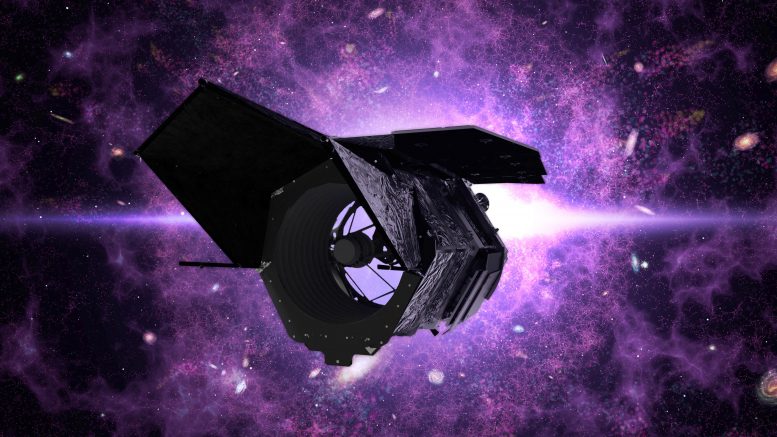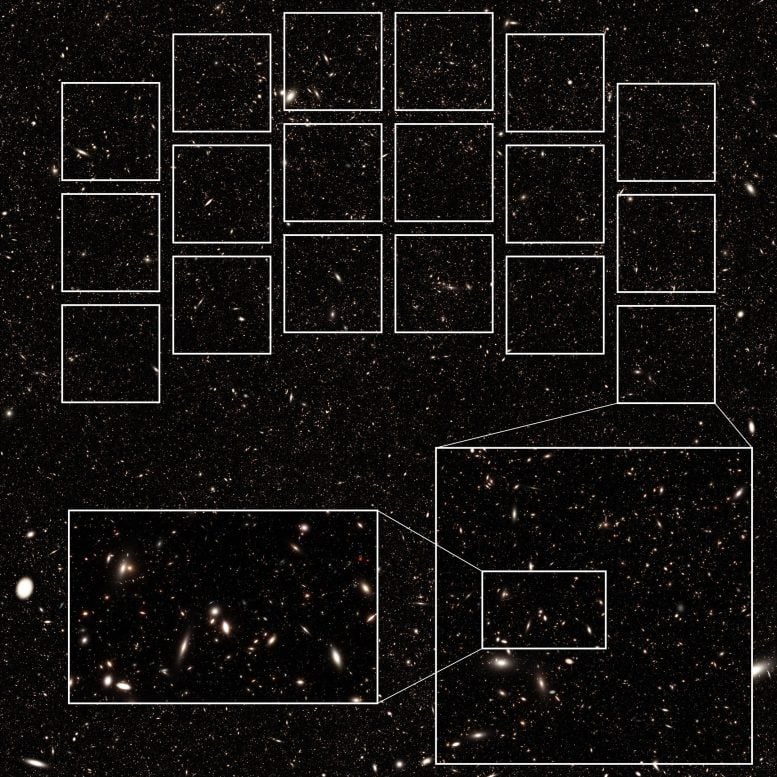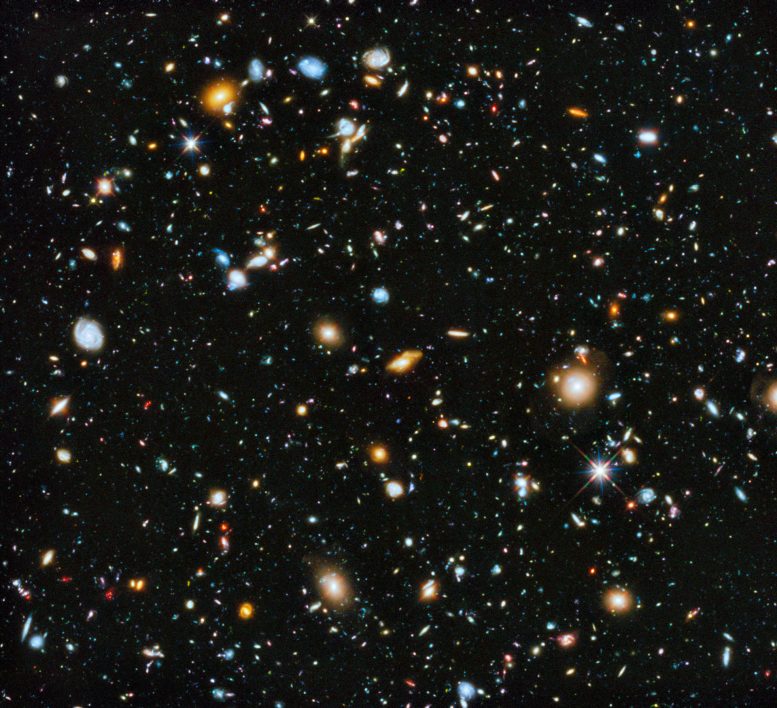
Posted on 01/21/2022 7:22:22 AM PST by Red Badger

The Roman Space Telescope is a NASA observatory designed to unravel the secrets of dark energy and dark matter, search for and image exoplanets, and explore many topics in infrared astrophysics. Credit: NASA
A team of astrophysicists has created a simulated image that shows how the Nancy Grace Roman Space Telescope could conduct a mega-exposure similar to but far larger than Hubble’s celebrated Ultra Deep Field Image. This Hubble observation transformed our view of the early universe, revealing galaxies that formed just a few hundred million years after the big bang.
“Roman has the unique ability to image very large areas of the sky, which allows us to see the environments around galaxies in the early universe,” said Nicole Drakos, a postdoctoral scholar at the University of California Santa Cruz, who led the study. “Our study helps demonstrate what a Roman ultra-deep field could tell us about the universe, while providing a tool for the scientific community to extract the most value from such a program.”
By capturing the Hubble Ultra Deep Field image, astronomers pulled aside the cosmic curtains to reveal that a tiny, seemingly empty slice of the sky was actually teeming with thousands of galaxies, each containing billions of stars. The Hubble team harnessed the power of a long exposure time – hundreds of hours between 2002 and 2012 – which allowed the telescope to collect more light than it could in a single, short observation. The resulting image helped us see more than 13 billion years back in time.

This synthetic image visualizes what a Roman ultra-deep field could look like. The 18 squares at the top of this image outline the area Roman can see in a single observation, known as its footprint. The inset at the lower-right zooms into one of the squares of Roman’s footprint, and the inset at the lower-left zooms in even further. The image, which contains more than 10 million galaxies, was constructed from a simulation that produced a realistic distribution of the galaxies in the universe. Roman could peer across more than 13 billion years of cosmic history, reaching back to when the universe was only about half a billion years old. Such distant galaxies are extremely faint, so Roman would have to stare at one spot in space for several days to collect enough light from them. The mission’s wide field of view will provide an incredible amount of data, helping astronomers find rare objects in the epoch of reionization. The large area Roman will observe will also show differences in galaxy properties based on their surrounding environment, allowing astronomers to better understand how early galaxies formed. Credit: Nicole Drakos, Bruno Villasenor, Brant Robertson, Ryan Hausen, Mark Dickinson, Henry Ferguson, Steven Furlanetto, Jenny Greene, Piero Madau, Alice Shapley, Daniel Stark, Risa Wechsler
Hubble’s Ultra Deep Field offers an incredible window to the early universe, but an extremely narrow one, covering less than one ten millionth of the whole sky. The new simulation showcases Roman’s power to perform a similar observation on a much larger scale, revealing millions of galaxies instead of thousands. While a Roman ultra-deep field would be just as sharp as Hubble’s and peer equally far back in time, it could reveal an area 300 times larger, offering a much broader view of cosmic ecosystems.
“The Hubble Ultra Deep Field gave us a glimpse of the universe’s youth, but it was too small to reveal much information about what the cosmos was really like back then as a whole,” said Brant Robertson, an astronomy professor at the University of California Santa Cruz and a co-author of the study. “It’s like looking at a single piece of a 10,000-piece puzzle. Roman could give us 100 connected puzzle pieces, offering a much better picture of what the early universe was like and opening up new scientific opportunities.”
To generate their simulated Roman ultra-deep field image, Drakos and co-authors created a synthetic catalog of galaxies, complete with detailed information about each one. By doing so, the team essentially created a mock universe, basing their synthetic galaxies on dark matter simulations and observation-based models. They made the galaxy catalog publicly available so other scientists can use it to prepare for future Roman observations. The team also created an interactive website where users can zoom and pan across the full-resolution image.
The team’s results will be published in The Astrophysical Journal.
VIDEO AT LINK..................
This video demonstrates how Roman could expand on Hubble’s iconic Ultra Deep Field image. While a similar Roman observation would be just as sharp as Hubble’s and see equally far back in time, it could reveal an area 300 times larger, offering a much broader view of cosmic ecosystems. Credit: NASA’s Goddard Space Flight Center
Looking far and wide Astronomers usually have to choose between taking a shallow, wide-area image and capturing a very sensitive, deep image since telescope time is a precious commodity. But with Roman’s enormous field of view and infrared vision, they will be able to peer far and wide simultaneously, opening up new avenues of cosmic exploration.
Drakos and co-authors show that a Roman ultra-deep field program could reveal more than a million galaxies scattered throughout cosmic history, from very young and small galaxies just beginning to form stars to the modern era, which features many massive, often relatively inactive galaxies. Scientists would be able to probe how galaxies transition from forming lots of new stars to this quieter stage, when star formation is complete.
The possible causes of this metamorphosis are currently poorly understood, but Roman’s wide viewing power could offer clues about how a galaxy’s environment, such as its location in relation to other galaxies or galaxy clusters, affects its star formation.

Hubble’s Ultra Deep Field image, first unveiled in 2004 with additional observations in subsequent years, revealed thousands of galaxies stretching back to within a few hundred million years of the big bang. Roman could perform a similar observation on a much larger scale, revealing millions of galaxies instead of thousands. A Roman ultra-deep field would offer a detailed view of the environments surrounding galaxies in different stages of development, providing clues about how they evolve. Credit: NASA, ESA, H. Teplitz and M. Rafelski (IPAC/Caltech), A. Koekemoer (STScI), R. Windhorst (Arizona State University), and Z. Levay (STScI)
Galaxies in which star formation has ended, known as quiescent galaxies, are increasingly difficult to find the farther back in time astronomers look.
“We’re not sure whether we haven’t detected very distant quiescent galaxies because they don’t exist, or simply because they’re so difficult to find,” Drakos said.
Drakos and co-authors showed that Roman’s ability to image large patches of the distant universe and reveal both rare and faint objects could help astronomers find as many as 100,000 quiescent galaxies, likely including some of the farthest ones ever discovered. Astronomers could also use Roman ultra-deep field observations to determine whether galaxies transition from star-forming to quiescent differently in different cosmic eras.
The end of the cosmic “dark ages” The team’s work shows that Roman could illuminate our understanding of a long-ago cosmic event called reionization. Shortly after the big bang, the universe was filled with a hot sea of plasma – charged particles – that formed a dense, ionized fluid. As the universe cooled, the particles were able to stick together to form hydrogen atoms, which resulted in a neutral hydrogen fog. This marked an era called the cosmic “dark ages” since this fog prevented shorter wavelengths of light, which may have been emitted from young, forming galaxies or quasars from traveling very far.
But then the neutral hydrogen atoms broke apart, returning to charged particles in an epoch of reionization. The fog lifted, transforming the universe from being mostly opaque to the brilliant starscape we see today. Findings from NASA’s Spitzer Space Telescope hint that the first galaxies released extremely high amounts of ionizing radiation – ultraviolet light, X-rays, and gamma rays – which could have disrupted the hydrogen fog.
A Roman ultra-deep field program could advance our understanding of the epoch of reionization by revealing wide images containing more than 10,000 galaxies from this relatively brief cosmic age, which happened sometime between when the universe was around 600 million to 900 million years old, and a detailed view of the environments around these galaxies. This could help scientists understand what caused reionization, when exactly it happened, and whether its occurrence was uniform or patchy.
Roman also has the power to reveal how galaxies and galaxy clusters – which form some of the largest structures in the universe – evolved over time. Scientists think galaxies were born within vast spherical clumps of dark matter called halos. Observations indicate that each galaxy’s luminosity, or absolute brightness, is linked to the mass of the dark matter halo it resides in. By creating an ultra-deep field image, Roman could help astronomers better understand this connection. This has implications for not only galaxy formation but also the standard cosmological model – the theoretical model of how the universe evolves – which includes a dark matter clumping parameter.
“Roman could shine a light on so many cosmic mysteries in just a few hundred hours of observing time,” said Bruno Villasenor, a graduate student at the University of California Santa Cruz and a co-author of the study. “It’s amazing to think that no one knew for sure whether other galaxies existed until about a hundred years ago. Now, Roman offers us the opportunity to observe thousands of the first galaxies that appeared in the very early universe!”
The Nancy Grace Roman Space Telescope is managed at NASA’s Goddard Space Flight Center in Greenbelt, Maryland, with participation by NASA’s Jet Propulsion Laboratory and Caltech/IPAC in Southern California, the Space Telescope Science Institute in Baltimore, and a science team comprising scientists from various research institutions. The primary industrial partners are Ball Aerospace and Technologies Corporation in Boulder, Colorado; L3Harris Technologies in Melbourne, Florida; and Teledyne Scientific & Imaging in Thousand Oaks, California.
PING!.....................
No, seven years of the darkest days ever known to man are about to begin (a few decades away IMO), in the revived Roman Empire and the “beast”.
WTF?
It will be able to see the DARK ROOTS of the UNIVERSE!...................
If they did, how much effect did it have?
If they didn't, why not?
And if they didn't, why am I supposed to believe that the matter in our immediate vicinity, out to a distance of one million miles at least, is devoid of the effects of "matter" that's supposed to make up 200 times more mass than the earth, moon, and sun?
HA!
They should have just gone with "The Nancy Roman Telescope".
Amazing stuff, and we are so lucky to be alive during this time of discovery.
They seem to be convinced there is a beginning that they can almost see, what they call the “Big Bang”. What if there’s not? So far, every improvement in resolution we gain has just shown more distant galaxies.
It’s turtles all the way down!
So it's going to look into the Pelosi family stock trades?
Objects like the earth tend to clear their immediate surroundings, so close to the earth (a million miles is close in space terms) you aren't going to find any matter that isn't either orbiting the earth or soon-to-be colliding with it.
Way over 99% of the gravity the Webb telescope "sees" is due only to the earth and the sun. Everything else is too far away, too small, or too thinly spread out.
If they can see 13 billion years back in time, and if the universe has been expanding from the size of a pea all that time, then why don’t those distant galaxies appear close to us?
Heck, I’ve always wanted to know if there is such a thing as up and down in the universe!
Can they tell by looking through these telescopes(?) if planets, moons and galaxies are floating in a great void or falling?
If everything is falling, where are they falling to?
If not falling, why not?
I suspect that if everything is falling,they are all falling at the same rate so there is no frame of reference, thus no way to tell!
Oh well!
Because some are going AWAY from us in the opposite direction............
More wonderful propaganda (that embraces every hot-button astrophysical word) to keep those big bucks flowing and careers on a bountiful 20-year career-track until retirement...
[here's the PR]
Scheduled to launch in the mid-2020s, the Nancy Grace Roman Space Telescope, formerly known as WFIRST, will function as Hubble’s wide-eyed cousin. While just as sensitive as Hubble's cameras, the Roman Space Telescope's 300-megapixel Wide Field Instrument will image a sky area 100 times larger. This means a single Roman Space Telescope image will hold the equivalent detail of 100 pictures from Hubble.
The mission’s wide field of view will allow it to generate a never-before-seen big picture of the universe, which will help astronomers explore some of the greatest mysteries of the cosmos, like why the expansion of the universe seems to be accelerating. Some scientists attribute the speed-up to dark energy, an unexplained pressure that makes up 68% of the total content of the cosmos.
The Wide Field Instrument will also allow the Roman Space Telescope to measure the matter in hundreds of millions of distant galaxies through a phenomenon dictated by Einstein’s relativity theory. Massive objects like galaxies curve space-time in a way that bends light passing near them, creating a distorted, magnified view of far-off galaxies behind them. The Roman Space Telescope will paint a broad picture of how matter is structured throughout the universe, allowing scientists to put the governing physics of its assembly to the ultimate test.
The Roman Space Telescope can use this same light-bending phenomenon to study planets beyond our solar system, known as exoplanets. In a process called microlensing, a foreground star in our galaxy acts as the lens. When its motion randomly aligns with a distant background star, the lens magnifies, brightens and distorts the background star. The Roman Space Telescope's microlensing survey will monitor 100 million stars for hundreds of days and is expected to find about 2,500 planets, well targeted at rocky planets in and beyond the region where liquid water may exist.
These results will make the Roman Space Telescope an ideal companion to missions like NASA's Kepler and the upcoming Transiting Exoplanet Survey Satellite (TESS), which are designed to study larger planets orbiting closer to their host stars. Together, discoveries from these three missions will help complete the census of planets beyond our solar system. The combined data will also overlap in a critical area known as the habitable zone, the orbiting distance from a host star that would permit a planet's surface to harbor liquid water — and potentially life.
By pioneering an array of innovative technologies, the Roman Space Telescope will serve as a multipurpose mission, formulating a big picture of the universe and helping us answer some of the most profound questions in astrophysics, such as how the universe evolved into what we see today, its ultimate fate and whether we are alone.
Music credit: "Climb the Ladder" from Universal Production MusicNASA's Nancy Grace Roman Space Telescope: Broadening Our Cosmic Horizons | May 20, 2020 | NASA Goddard
Disclaimer: Opinions posted on Free Republic are those of the individual posters and do not necessarily represent the opinion of Free Republic or its management. All materials posted herein are protected by copyright law and the exemption for fair use of copyrighted works.